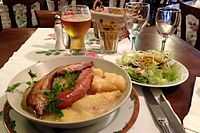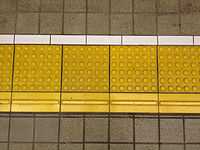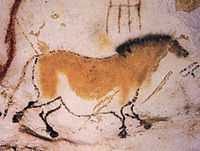Art

"Art is a diverse range of human activities and the products of those activities".[1]
Humanities
"The purpose of incorporating humanities teaching into medical education is to encourage students to develop into more sensitive and caring doctors who communicate well with their patients and colleagues."[2]
Colors

It "is possible for a painter to generate all colors by mixing together different ratios of three suitably chosen primaries, but, in fact, most painters use a wide range of paint colors."[3]
Minerals
"Small catalogues of reference Raman spectra of interest for analysing geomaterials or biomaterials of relevance to art history or archaeology are gradually being published by different research groups."[4]
Art theory
Def. "[t]he conscious production or arrangement of sounds, colours, forms, movements, or other elements in a manner that affects the sense of beauty, specifically the production of the beautiful in a graphic or plastic medium"[5] is called art.
Senses
Many art forms involve more than one sense.
"The theme of the Five Senses made its first appearance in the Early Middle Ages.1 From the outset, with the extraordinary Fuller broach in the British Museum, which dates from the ninth century, its monuments practically all belong to secular imagery.2 There are scattered instances in Romanesque art, but only from the thirteenth century on do the Senses become more frequently depicted."[6]
Audio
Audio (US) source, audio expression of the English pronunciation of the word skill.
"Besides technological developments, the evolution of digital sound and music was shaped by a multitude of earlier musical experiments that pointed to the possibilities of the new medium."[7]
Gustatory

Although the image at right is of a plate of food specific to Ardennes, France, when the food is eaten, it may be considered pleasing.
"La cacasse à cul nu est un plat typique et symbolique de la cuisine ardennaise. C'était à l’origine un plat simple et nourrissant, une fricassée de pommes de terre, cuites dans un roux, dans une cocotte en fonte, que les personnes les plus modestes consommaient quand la viande était inabordable6."[8]
Tactile

As an example of tactile art there is the tactile paving at right shown in the photograph.
Functionally, the paving helps blind individuals locate the platform end. Is this only functional paving or is it also tactile art, especially to those who are blind and perceive it?
Visuals
"[T]he visual arts [include] the creation of images or objects in fields [like] painting, sculpture, printmaking, [and] photography".[1]
Beauty
Def. "[t]he property, quality or state of being "that which pleases merely by being perceived" (Aquinas)"[9] is called beauty.
Skills
Def. a "[c]apacity to do something well"[10] is called a skill.
Medium
"An artistic medium is the substance or material the artistic work is made from, and may also refer to the technique used."[1]
Form
"An art form is the specific shape, or quality an artistic expression takes. The media used often influence the form. For example, the form of a sculpture must exist in space in three dimensions, and respond to gravity. The constraints and limitations of a particular medium are thus called its formal qualities."[1]
Genre
"A genre is a set of conventions and styles within a particular medium."[1]
Style
"The style of an artwork, artist, or movement is the distinctive method and form followed by the respective art."[1]
Aesthetics
Def. "[t]he study or philosophy of beauty"[11] is called aesthetics.
Chemistry
"The botanical sources and chemical compositions [...] of natural resins [are] used, [or] likely to have been used, in the fabrication of objects of art and archaeology. They fall into two main chemical groups: those containing diterpenoids—from the order Coniferales and from the Leguminosae family—and those containing triterpenoids from several families of broad-leaved trees."[12]
History


"Sculptures, cave paintings, rock paintings and petroglyphs from the Upper Paleolithic dating to roughly 40,000 years ago have been found".[1]
"New dating of cave paintings [a portion is shown on the left] in Indonesia reveals that they are more than 40,000 years old, casting doubt on theories of art in human prehistory. These paintings are among the earliest ever found, and their location is a surprise to archaeologists. Other contemporary cave art has been found only in Europe, and archaeologists thought that the practice of cave painting originated there. The revised age measurements, combined with previous findings that some carved patterns in Africa are 50,000 years old, suggest that humans may have developed artistic proclivities before their migration out of Africa, beginning around 75,000 years ago."[13]
"The oldest art objects in the world—a series of tiny, drilled snail shells about 75,000 years old—were discovered in a South African cave.[14] Containers that may have been used to hold paints have been found dating as far back as 100,000 years.[15]"[1]
Research
Hypothesis:
- Art can be free of a dominant group.
Control groups

The findings demonstrate a statistically systematic change from the status quo or the control group.
“In the design of experiments, treatments [or special properties or characteristics] are applied to [or observed in] experimental units in the treatment group(s).[16] In comparative experiments, members of the complementary group, the control group, receive either no treatment or a standard treatment.[17]"[18]
Proof of concept
Def. a “short and/or incomplete realization of a certain method or idea to demonstrate its feasibility"[19] is called a proof of concept.
Def. evidence that demonstrates that a concept is possible is called proof of concept.
The proof-of-concept structure consists of
- background,
- procedures,
- findings, and
- interpretation.[20]
See also
References
- 1 2 3 4 5 6 7 8 "Art, In: Wikipedia". San Francisco, California: Wikimedia Foundation, Inc. April 9, 2013. Retrieved 2013-04-19.
- ↑ Ruric Anderson and David Schiedermayer (2003). "The Art of Medicine through the Humanities: an overview of a one‐month humanities elective for fourth year students". Medical Education 37 (6): 560-2. doi:10.1046/j.1365-2923.2003.01538.x. http://onlinelibrary.wiley.com/doi/10.1046/j.1365-2923.2003.01538.x/full. Retrieved 2014-07-02.
- ↑ Margaret Livingstone (2002). DH Hubel. ed. Vision and Art - The Biology of Seeing. GoogleDrive. https://www.googledrive.com/host/0B4QDaAzM9KaiTkRPc2pBSFhxUm8/Biology/019receptors/Further%20reading/Vision%20Article.pdf. Retrieved 2014-07-01.
- ↑ M. Bouchard, D.C. Smith (August 2003). "Catalogue of 45 reference Raman spectra of minerals concerning research in art history or archaeology, especially on corroded metals and coloured glass". Spectrochimica Acta Part A: Molecular and Biomolecular Spectroscopy 59 (10): 2247-66. doi:10.1016/S1386-1425(03)00069-6. http://www.sciencedirect.com/science/article/pii/S1386142503000696. Retrieved 2014-07-02.
- ↑ "art, In: Wiktionary". San Francisco, California: Wikimedia Foundation, Inc. March 26, 2013. Retrieved 2013-04-19.
- ↑ Carl Nordenfalk (1985). "The Five Senses in Late Medieval and Renaissance Art". Journal of the Warburg and Courtauid Institutes 48: 1-22. http://storage.ugal.com/3871/nordenfalk---the-five-senses2.pdf. Retrieved 2014-07-02.
- ↑ Christiane Paul (2003). Thames & Hudson. ed. Digital Art, In: world of art. Flong.com. pp. 132-6. http://www.flong.com/storage/pdf/press/2003_paul_digitalart.pdf. Retrieved 2014-07-02.
- ↑ "Cacasse à cul nu, In: Wikipedia". San Francisco, California: Wikimedia Foundation, Inc. février 26, 2013. Retrieved 2013-04-20.
- ↑ "beauty, In: Wiktionary". San Francisco, California: Wikimedia Foundation, Inc. April 20, 2013. Retrieved 2013-04-20.
- ↑ "skill, In: Wiktionary". San Francisco, California: Wikimedia Foundation, Inc. December 13, 2012. Retrieved 2013-04-20.
- ↑ "aesthetics, In: Wiktionary". San Francisco, California: Wikimedia Foundation, Inc. February 25, 2013. Retrieved 2013-04-20.
- ↑ John S. Mills and Raymond White (February 1977). "Natural Resins of Art and Archaeology Their Sources, Chemistry, and Identification". Science and Technology of Archaeological Research 22 (1): 12-31. http://www.maneyonline.com/doi/abs/10.1179/sic.1977.003. Retrieved 2014-07-02.
- ↑ Katie Burke (1 January 2015). "Humans Made Art Earlier". Sigma Xi. Retrieved 2015-01-11.
- ↑ Tim Radford (April 16, 2004). "World's Oldest Jewellery Found in Cave". Guardian Unlimited. http://education.guardian.co.uk/higher/artsandhumanities/story/0,12241,1193237,00.html. Retrieved January 18, 2008.
- ↑ "African Cave Yields Evidence of a Prehistoric Paint Factory". The New York Times. 13 October 2011. http://www.nytimes.com/2011/10/14/science/14paint.html.
- ↑ Klaus Hinkelmann, Oscar Kempthorne (2008). Design and Analysis of Experiments, Volume I: Introduction to Experimental Design (2nd ed.). Wiley. ISBN 978-0-471-72756-9. http://books.google.com/?id=T3wWj2kVYZgC&printsec=frontcover.
- ↑ R. A. Bailey (2008). Design of comparative experiments. Cambridge University Press. ISBN 978-0-521-68357-9. http://www.cambridge.org/uk/catalogue/catalogue.asp?isbn=9780521683579.
- ↑ "Treatment and control groups, In: Wikipedia". San Francisco, California: Wikimedia Foundation, Inc. May 18, 2012. Retrieved 2012-05-31.
- ↑ "proof of concept, In: Wiktionary". San Francisco, California: Wikimedia Foundation, Inc. November 10, 2012. Retrieved 2013-01-13.
- ↑ Ginger Lehrman and Ian B Hogue, Sarah Palmer, Cheryl Jennings, Celsa A Spina, Ann Wiegand, Alan L Landay, Robert W Coombs, Douglas D Richman, John W Mellors, John M Coffin, Ronald J Bosch, David M Margolis (August 13, 2005). "Depletion of latent HIV-1 infection in vivo: a proof-of-concept study". Lancet 366 (9485): 549-55. doi:10.1016/S0140-6736(05)67098-5. http://www.ncbi.nlm.nih.gov/pmc/articles/PMC1894952/. Retrieved 2012-05-09.
External links
| |||||||||||||||||||||||||||||||||||||||||||||||||||||
| ||||||||||||||||||||||||||||||||||||||||||||
![]() This is a research project at http://en.wikiversity.org
This is a research project at http://en.wikiversity.org
| |
Resource type: this resource is an article. |
| |
Resource type: this resource contains a lecture or lecture notes. |
| |
Subject classification: this is a humanities resource. |